
The peony or paeony is any flowering plant in the genus Paeonia, the only genus in the family Paeoniaceae. Peonies are native to Asia, Europe, and Western North America. Scientists differ on the number of species that can be distinguished, ranging from 25 to 40, although the current consensus describes 33 known species. The relationships between the species need to be further clarified.

Lonicera japonica, known as Japanese honeysuckle and golden-and-silver honeysuckle, is a species of honeysuckle native to East Asia, including many parts of China. It is often grown as an ornamental plant, but has become an invasive species in a number of countries. It is used in traditional Chinese medicine.

Paeonia rockii, or Rock's peony, is a woody species of tree peony that was named after Joseph Rock. It is one of several species given the vernacular name tree peony, and is native to the mountains of Gansu and adjoining provinces in China. In Chinese, it is known as 紫斑牡丹.
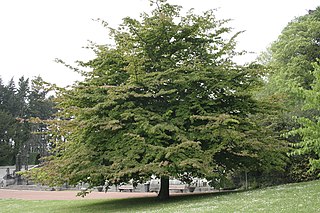
Parrotia persica, the Persian ironwood, is a deciduous tree in the family Hamamelidaceae, closely related to the witch-hazel genus Hamamelis. It is native to Iran's Caspian region and Azerbaijan. It is endemic in the Alborz mountains, where it is found mainly in Golestan National Park.

Paeonia brownii is a low to medium height, herbaceous perennial flowering plant in the family Paeoniaceae. It has compound, steely-gray, somewhat fleshy leaves and small drooping maroon flowers. Its vernacular name is Brown's peony, native peony or western peony. It is native to the western United States and usually grows at altitude, often as undergrowth in part-shade. The fleshy roots store food to carry the plant through the dry summers and produce new leaves and flowers the following spring.
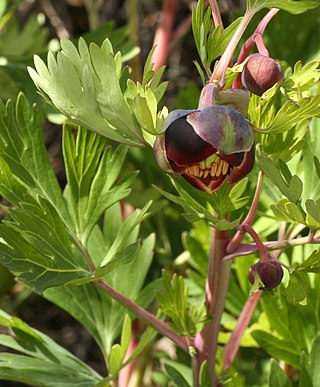
Paeonia californica is a perennial herbaceous plant of 35–70 cm high, that retreats underground in summer, and reoccurs with the arrival of the winter rains. It has lobed leaves, elliptic (cup-shaped) drooping flowers with dark maroon-colored petals, and many yellow anthers. It flowers mostly from January to March, and later develops two to five fruits per flower. Its common name is California peony and it is sometimes also referred to as wild peony. This peony is an endemic of southwestern California (USA), where it is not rare, and northernmost Baja California (Mexico). It grows on dry hillsides in the coastal sage scrub and chaparral communities of the coastal mountains of Southern and Central California, often as an understory plant.

Plumeria obtusa, the Singapore graveyard flower, is a species of the genus Plumeria (Apocynaceae). It is native to the Neotropics, but widely cultivated for its ornamental and fragrant flowers around the world, where suitably warm climate exists.
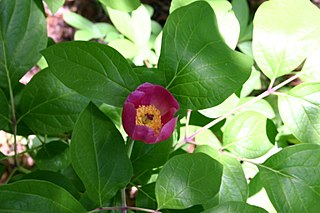
Paeonia obovata is a perennial herbaceous species of peony growing 30–70 cm high. It has white, pink or purple-red flowers and its lower leaves consist of no more than nine leaflets or segments. In English it is sometimes called woodland peony. It grows naturally in warm-temperate to cold China, including Manchuria, and in Korea, Japan, Far Eastern Russia and on Sakhalin.

Tree peony is the vernacular name for the section Moutan of the plant genus Paeonia, or one of the species or cultivars belonging to this section. It consists of shrubs that have perennial aerial woody stems. Other peonies do not have perennial woody stems, but their stems die back after the growing season, to emerge again from buds just below the surface early in the following year. Tree peonies have been in culture in China for millennia, and it is likely that hybrids came into being in gardens, where different wild tree peony species were planted closely together. They are used in China both for medicine and as an ornamental, particularly the hybrids called Paeonia suffruticosa. These hybrids in particular, but other tree peonies too, are called mǔdān (牡丹) in China.

Artemisia palmeri is a rare species of sagebrush known by the common names San Diego sagewort and Palmer sagewort.
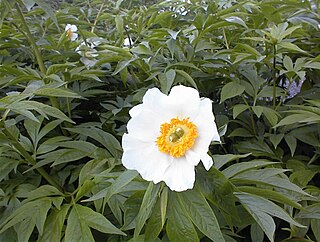
Paeonia emodi is a robust herbaceous perennial plant that winters with buds underground, has large white flowers and large, deeply incised leaves. It belongs to the family Paeoniaceae. Its local vernacular names include mamekhor or mamekh (Punjabi), ood-e-saleeb (Urdu) meaning "with-a-cross", ood salap (Hindi), mid and 多花芍药 meaning "multi-flower peony". In English it is sometimes called Himalayan peony. It is among the tallest of the herbaceous peony species, and, while cold-hardy, it grows better in warm, temperate climates. It is a parent of the popular hybrid 'White Innocence', which reaches 1+1⁄2 m.

Paeonia delavayi is a low woody shrub belonging to the peony family, and is endemic to China. The vernacular name in China is 滇牡丹. In English it is called Delavay's tree peony, Delavay peony, Dian peony, and dian mu dan. It mostly has reddish-brown to yellow, nodding flowers from mid May to mid June. The light green, delicate looking deciduous leaves consist of many segments, and are alternately arranged on new growth.

Paeonia ludlowii is a deciduous shrub of medium height, belonging to the tree peony section Moutan of the genus Paeonia, and endemic to southeast Tibet. In Tibet it is known as ≠'lumaidao' meaning "God's flower". The vernacular name in Chinese is 大花黄牡丹 meaning "big yellow-flowered peony". In English it is sometimes called Tibetan tree peony or Ludlow's tree peony. It has pure yellow, slightly nodding, bowl-shaped flowers, and large, twice compounded, light green leaves.

Paeonia × suffruticosa is a name used for a group of cultivars of tree peonies that are the result of hybridisation with species exclusively belonging to the subsection Vaginatae. The common name used in China is mǔdān. Plants belonging to this group have been cultivated for millennia in China, initially only as a source of traditional Chinese medicine particularly the skin of its roots. Already early on the plant was also cultivated for its ornamental value, and it is highly revered in Chinese culture.

Paeonia ostii is a hardy shrub in the peony family, Paeoniaceae. It can be found in the Gansu, Anhui, Shaanxi and Henan provinces of China. It can reach heights of 1.5 m, and has grey-brown bark and lance-shaped leaflets. Flowers are produced in mid-spring, measure up to 15 cm across, and are typically pure white without basal blotches. The flowers can sometimes be faintly tinged with pink.
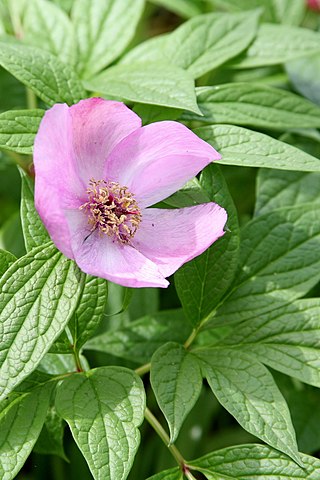
Paeonia mairei is a species of peony, that is endemic to the mountains of central China. Its vernacular name in China is 美丽芍药 meaning "beautiful peony". The plant may be between 45 and 100 cm high and has mostly rose-pink flowers of about 10 cm across, one on each stem. P. mairei blooms in early spring.
Paeonia sterniana is a perennial, herbaceous peony of approximately 45 cm high in cultivation, with white or sometimes pinkish flowers. It grows in the wild in southeastern Tibet. This peony is very rare in cultivation. It produces blue seeds in autumn. Its common name in Chinese is 白花芍药, which means "white peony".

Paeonia anomala is a species of herbaceous perennial flowering plant in the family Paeoniaceae. This peony is ½–1 m high, with a thick irregular taproot and thin side roots. The deeply incised leaves have leaflets which are themselves divided in fine segments. It flowers in early summer, almost always with only one fully developed flower per stem, usually magenta-red or more rarely, pink or white. The species occurs in a zone between northern European Russia and northern Mongolia and south to the Tien Shan Mountains.
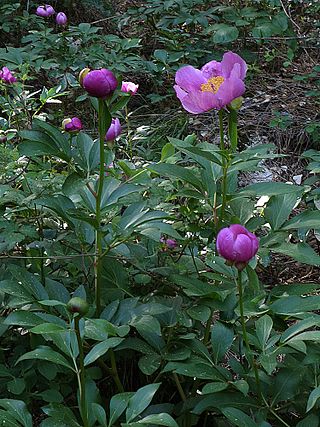
Paeonia coriacea, also known as the Andalusian peony, is a species of flowering plant within the family Paeoniaceae.

Syringa pinnatifolia, the pinnate lilac, is a deciduous shrub in the genus Syringa, in the family Oleaceae. It is native to Western China.

















